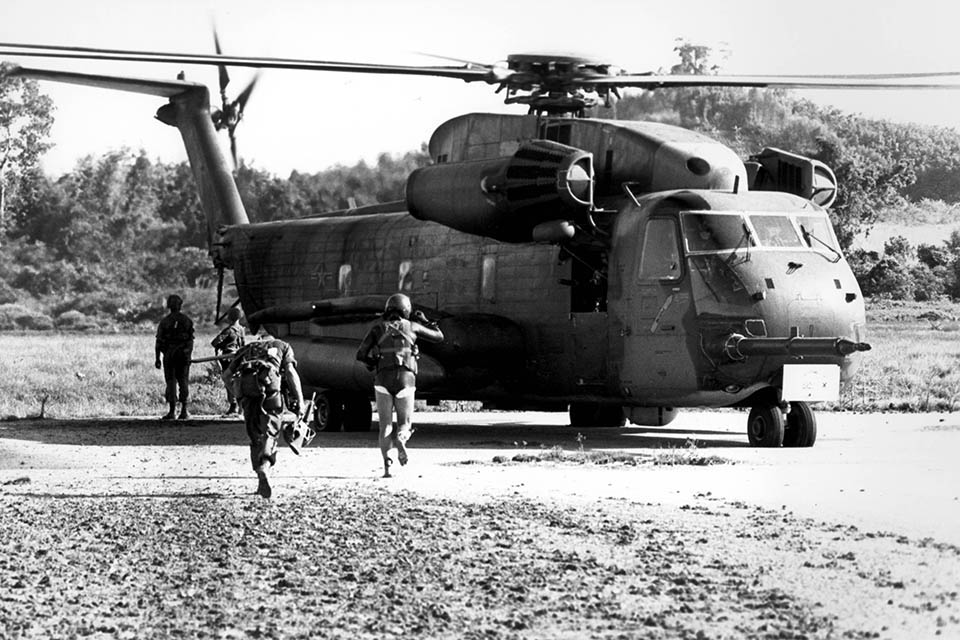At about 0200 hours on November 21, 1970, a Sikorsky HH-53, call sign Apple 03, flew toward the Son Tay POW camp 23 miles west of Hanoi. Apple 03’s miniguns made short work of the guard towers, after which two other HH-53s landed support teams nearby as the main assault group seized and searched the camp for Americans, but the prisoners had been removed and the camp was empty. The HH-53s extracted the assault teams and departed at 0248, exiting North Vietnamese air space by 0315 and landing at Udorn, Thailand, an hour later. Although no prisoners were rescued, the mission forced the North Vietnamese to consolidate their POWs in a central location, an act that ultimately improved their living conditions and morale.
An improved variant of the Marines’ CH-53A, the HH-53 was modified for combat search and rescue (CSAR) over hostile territory. It had more powerful engines than its Marine counterpart, a retractable refueling probe, self-sealing fuel tanks, three six-barrel GAU-2/A 7.62mm miniguns, approximately 1,200 pounds of armor and a high-powered rescue hoist. Its equipment included a Doppler navigation radar and electronic sensing systems.
The CH-53 had arisen from a Marine Corps requirement to replace its aging piston-engine HR-2S helicopters. The Corps chose Sikorsky’s single-rotor S-65 design over Boeing’s twin-rotor CH-47 Chinook. The first CH-53As entered production in 1966 and quickly demonstrated the helicopter’s utility in Indochina’s hot and humid climate. Noting its performance, Air Force leaders ordered a “minimum-change” CSAR variant to replace its then-current HH-3 “Jolly Green” helicopter. The first CH-53 flew on March 15, 1967. The first “Super Jolly Greens” to arrive in theater that September were assigned to the 40th Aerospace Rescue and Recovery Squadron.
Upgrades came quickly. In addition to more powerful engines, Sikorsky installed or retrofitted faster, lighter and more flexible digital electronics and countermeasures equipment. The HH-53’s engines and transmission were adapted by the USMC’s CH-53D, which entered service after 1970. The Marines’ CH-53D excluded the armor, electronic countermeasure systems, radar, refueling probe and miniguns, giving it a heavier cargo carrying capacity (10,000 kg), but it had the same troop-carrying capacity (36 fully equipped infantrymen or 22 litter cases).

The HH-53’s armor, heavy lift capability, maneuverability, range and speed made it ideal for CSAR and special ops. The HH-53 was quick and easy to refuel and rearm. In fact, Apple 04 and 05 took off from Udorn within an hour of landing there after the Son Tay Raid to join the rescue of an F-105 pilot downed over Laos, refueling in the air. Used in virtually every high-risk CSAR and special operations mission of the war, some 14 HH-53s were lost in combat. In addition to the Son Tay Raid, they were also used in the 1975 Mayaguez incident.
Crew: 5
Rotor Diameter: 72 ft. 3 in.
Length: 88 Ft. 6 in.
Loaded weight: 33,500 lbs
Empty weight: 23,628 lbs
Power: 2 T64-GE-7 turboshafts with 3,925 shaft horsepower
Max. speed: 196 mph
Max. Range: 540 nautical miles
This feature was first published in the February 2012 issue Vietnam magazine.





